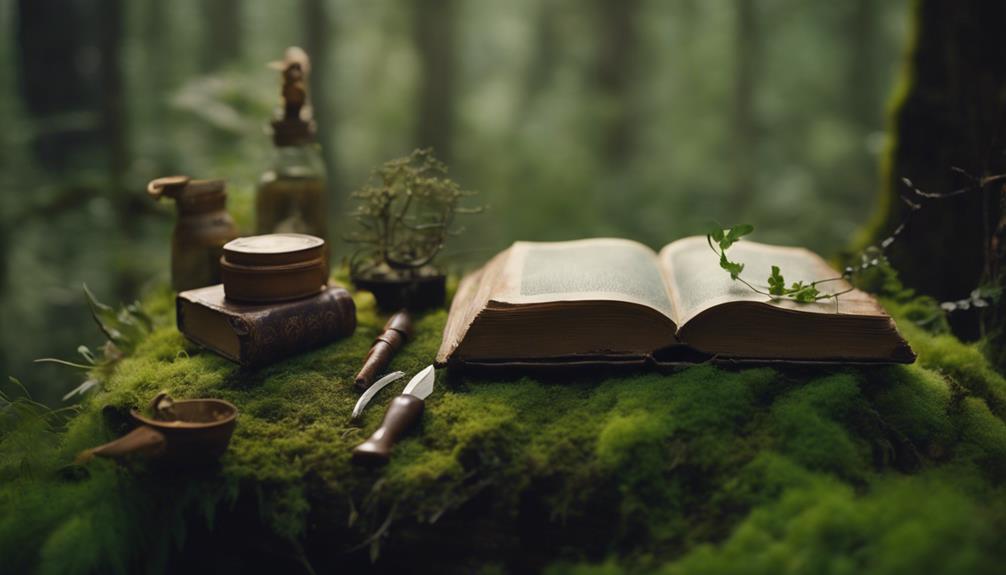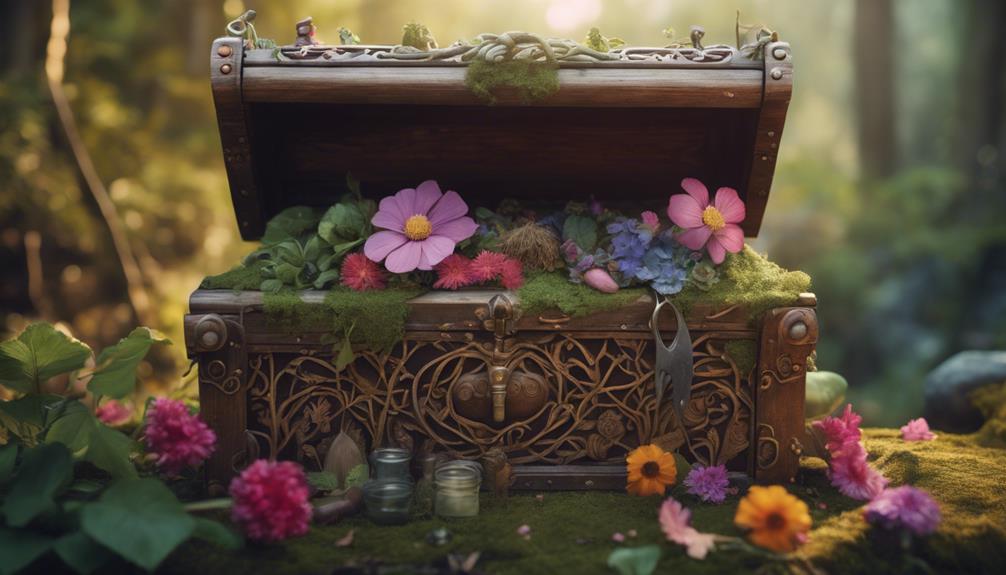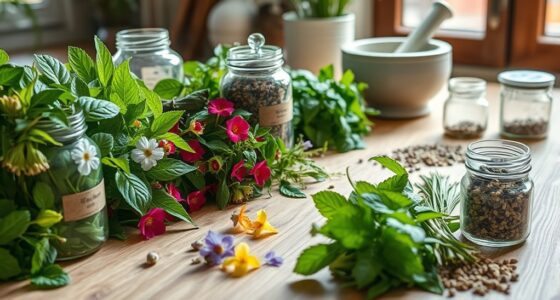We've struggled to balance mining and herbalism, wasting precious time switching between the two. However, by leveraging macros, addons, and strategic workflow optimization, we can efficiently track and gather both simultaneously. By creating macros for easy switching, utilizing addons like GatherMate2, and optimizing our gathering workflow, we can streamline our resource gathering experience. With the right tools and strategies, we can enhance our gameplay and workflow, providing a seamless user experience. As we master the art of dual tracking, we'll discover even more ways to optimize our resource gathering routine.
Key Takeaways
• Utilize macros for efficient tracking, allowing seamless switching between Mining and Herbalism abilities.
• Leverage addons like GatherMate2 to display spawn points for both resources simultaneously.
• Assign keybindings for easy tracking focus switching, simplifying the tracking process.
• Implement strategies like dual-boxing in windowed mode to optimize resource gathering workflow.
• Combine tools like Gatherer addon and JavaScript-enabled apps to enhance herbalism and mining tracking.
Mastering the Art of Dual Tracking
As we explore the world of dual tracking, we're faced with the challenging task of juggling two professions at once, but with the right strategies, we can master the art of simultaneously tracking Mining and Herbalism.
To efficiently track herbs, we can utilize a macro that toggles between tracking herbs and minerals with a single key press, allowing us to quickly switch between the two professions. Additionally, we can use addons like GatherMate2 to display both herb bushes and mineral veins simultaneously on our minimap, making it easier to locate and track our desired resources.
Understanding Find Herbs and Find Minerals

We rely on two essential tracking abilities, Find Herbs and Find Minerals, to detect nearby herb bushes and mineral veins on our minimap. These abilities are critical for efficient mining and herbalism, allowing us to locate valuable resources quickly. However, it's important to understand that only one tracking ability can be active at a time, requiring us to manually switch between tracking herbs and minerals.
Here's how these abilities enhance our gathering experience:
- Vibrant icons on our minimap, indicating the proximity of herb bushes or mineral veins
- Accurate detection of nearby resources, ensuring we don't miss valuable finds
- Streamlined gathering, as we can focus on the most profitable resources
- Improved navigation, with clear indicators guiding us to the desired resources
Creating Macros for Easy Switching

By setting up a macro, we can toss out the hassle of manual switching and toggle between Find Minerals and Find Herbs with a single click. This convenient feature allows us to efficiently track both Mining and Herbalism skills simultaneously, saving us time and effort in the process.
| Macro Benefits | Description | Advantages |
|---|---|---|
| Single-Click Switching | Toggle between Find Minerals and Find Herbs | Quick and easy switching |
| Keybinding Assignment | Assign a key to the macro | Seamless tracking focus switching |
| Reduced Manual Effort | Eliminate manual switching hassle | Increased efficiency in resource gathering |
| Simplified Tracking | Alternate between tracking minerals and herbs effortlessly | Enhanced resource gathering experience |
| Streamlined Gameplay | Focus on gathering resources, not switching skills | Improved overall gaming experience |
Visualizing Spawn Points With Addons

We've streamlined our resource gathering process with macros, and now we're taking it to the next level by utilizing addons that visualize spawn points for mining nodes and herb bushes. These addons create a thorough database of known node locations, making it easier to track and collect resources.
Here's what we can expect from these addons:
- Nodes on the minimap, providing a clear visual representation of nearby resource locations
- Customizable settings to highlight specific types of nodes for better visibility
- Icons or markers on the minimap, serving as visual cues to indicate nearby resource nodes
- A detailed database of known node locations, updated in real-time as we gather resources
Optimizing Your Gathering Workflow

To further streamline our resource gathering process, let's optimize our workflow by implementing a few key strategies that simplify tracking and switching between mining and herbalism.
One approach is to create a macro that allows us to efficiently switch between tracking mining and herbalism on our minimap. This way, we can quickly toggle between the two without having to navigate through multiple menus.
Additionally, we can utilize addons like GatherMate2 to display both mining and herbalism nodes simultaneously, making it easier to track and prioritize our resource gathering.
Another option is to experiment with dual-boxing in windowed mode, where we can track mining on one character and herbalism on another. We can also create a key binding to easily swap between tracking mining, herbalism, and other resources.
The Benefits of Toggling Abilities

As we switch between Find Minerals and Find Herbs abilities, we access a more streamlined resource gathering experience. This toggling ability allows us to efficiently track mining and herbalism nodes, saving us time and effort in the process.
By utilizing a macro to switch between tracking abilities, we can focus on specific resources depending on our current needs or profession requirements.
Here are just a few benefits of toggling abilities:
- We can quickly identify the most valuable herbs in a given area, allowing us to prioritize our gathering efforts.
- We can easily switch between mining and herbalism, ensuring we don't miss out on valuable resources.
- We can adapt to changing circumstances, such as depleted resource nodes or unexpected competition.
- We can maximize our gathering efficiency, reducing the time spent searching for resources and increasing our overall productivity.
Streamlining Your Gathering Routine

By streamlining our gathering routine, we can shave precious minutes off our resource collection time. As Classic General players, we know that every minute counts when it comes to collecting valuable resources.
To optimize our gathering experience, we can utilize various techniques. For instance, creating a macro to switch between tracking mining and herbalism on our minimap with a single button press can save us a significant amount of time.
Additionally, using addons like Gatherer can display both herb bushes and mineral veins on our map simultaneously, making it easier to locate resources. We can also experiment with dualboxing in windowed mode, allowing us to have different tracking settings for mining and herbalism on separate characters.
Essential Tools for Efficient Tracking
As we explore the essential tools for efficient tracking, we'll examine two pivotal components: Mining Log Templates and Herbalism Journal Apps.
These tools enable us to systematically record and analyze our gathering activities, allowing us to identify patterns and optimize our routes.
Mining Log Templates
We rely on mining log templates to meticulously record our mining activities, ensuring that we don't overlook important details like ore types, quantities, and locations. By using these templates, we can efficiently track our progress, identify trends, and plan our routes for the best mining outcomes.
We can customize our templates to include additional information, such as respawn times, notes, and favorite farming spots.
- Digital or physical templates: We can create digital or physical versions of our mining logs, depending on our preferences and playstyles.
- Streamlined gathering: Mining log templates help us streamline our gathering process, making it easier to collect resources.
- Optimizing routes: With these templates, we can plan our routes more efficiently, reducing travel time and increasing productivity.
- Tracking progress: By tracking our progress, we can identify areas for improvement and adjust our strategies accordingly.
Herbalism Journal Apps
How can we optimize our herbalism experience with the right tools, and what makes herbalism journal apps an essential part of our gathering arsenal?
These apps have revolutionized the way we track and manage our herbalism endeavors. With features like visual maps of herb nodes, we can plan our gathering routes more efficiently. We can also keep a record of herb respawn times, allowing us to optimize our farming efficiency.
Moreover, some apps offer note-taking and route planning features, making it easier to share data with fellow gatherers. By using these apps, we can enhance our overall gathering experience by having valuable information and organization tools at our fingertips.
When viewed with JavaScript enabled, these apps provide a seamless and user-friendly experience. By leveraging these tools, we can streamline our herbalism experience and take our gathering skills to the next level.
Putting It All Together for Success

By streamlining our gathering workflow and leveraging the right tools, we can efficiently track mining and herbalism nodes and maximize our resource gathering potential.
To achieve this, we need to put all the pieces together.
Here are some key strategies to help us succeed:
- Bind a macro to easily swap between searching for herbs, minerals, and other resources during gameplay.
- Utilize an addon like Gatherer to display both herb and mineral spawn points simultaneously on our minimap.
- Experiment with dualboxing in windowed mode to track minerals on one character and herbs on another.
- Explore community resources and forums for tips on optimizing tracking for mining and herbalism in WoW.
Frequently Asked Questions
How to Track Herbs and Minerals at the Same Time in Wow Classic?
We've struggled with tracking herbs and minerals simultaneously in WoW Classic, but unfortunately, it's not possible to do so natively.
The game only allows us to track either herbs or minerals at a time. However, we've found workarounds like using macros to switch between tracking modes, and add-ons like Gatherer that display possible spawn points for both.
Can You Track Both Herbs and Minerals in Wotlk?
As we venture into the vast virtual world of WotLK, we're often asked: can we track both herbs and minerals simultaneously?
Unfortunately, the answer is no. Unlike our imagination, where we envision effortlessly spotting both, the game's mechanics don't allow it.
We can only activate one tracking ability at a time, forcing us to choose between herbs and minerals.
What Addon Switches Between Find Herbs and Find Minerals?
We've found that there isn't a specific addon that directly switches between Find Herbs and Find Minerals. However, we can achieve this functionality by creating a macro that toggles between the two abilities. This allows us to efficiently switch between tracking herbs and minerals without having to manually swap abilities.
What Level of Herbalism for Outland?
To efficiently gather herbs in Outland, we need to focus on our Herbalism skill level. We found that a minimum skill level of 300 is required to gather herbs effectively, but some herbs require a higher level of 325.
As we improve our Herbalism skill, we'll reveal more herb nodes and access rare, valuable herbs.
Conclusion
As we wrap up our guide to efficiently tracking mining and herbalism, we've learned that mastering this dual skillset is like solving an intricate puzzle – it requires precision, strategy, and the right tools.
By creating macros, visualizing spawn points, and optimizing our workflow, we've streamlined our gathering routine, saving time and increasing productivity.
With the right mindset and essential tools, we can now tackle both mining and herbalism with ease, reaping the rewards of our hard work and dedication.









